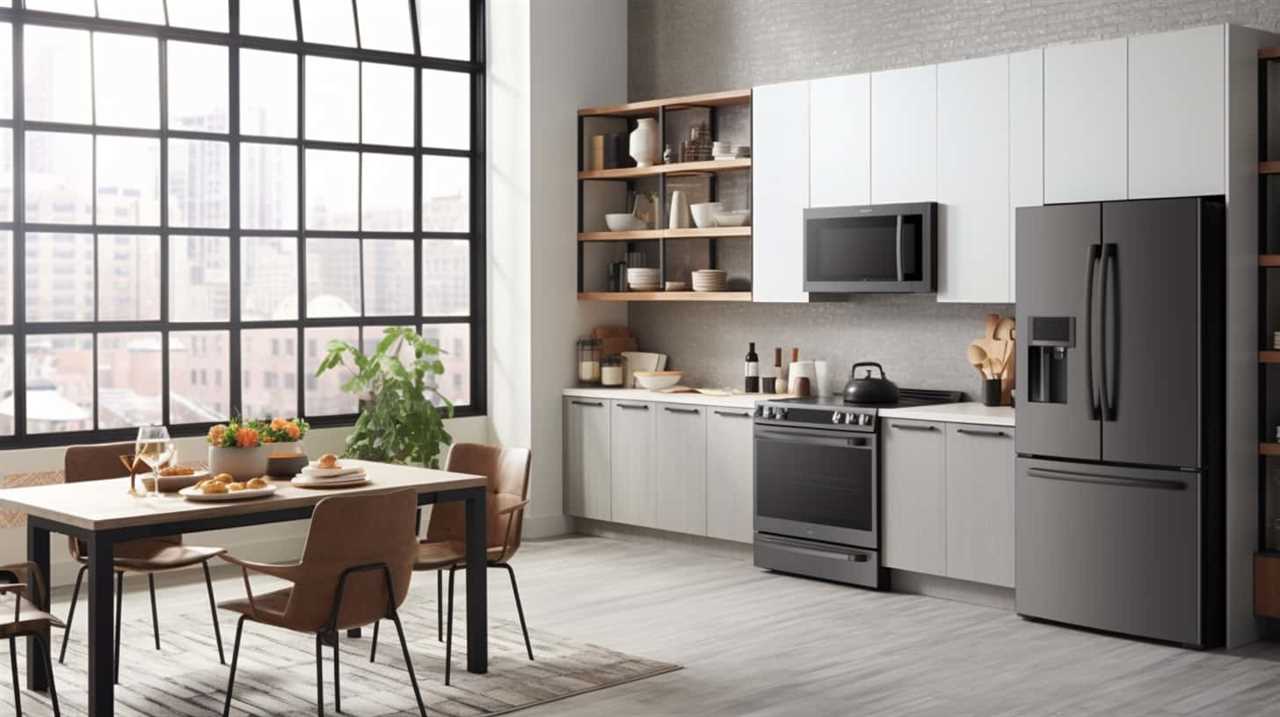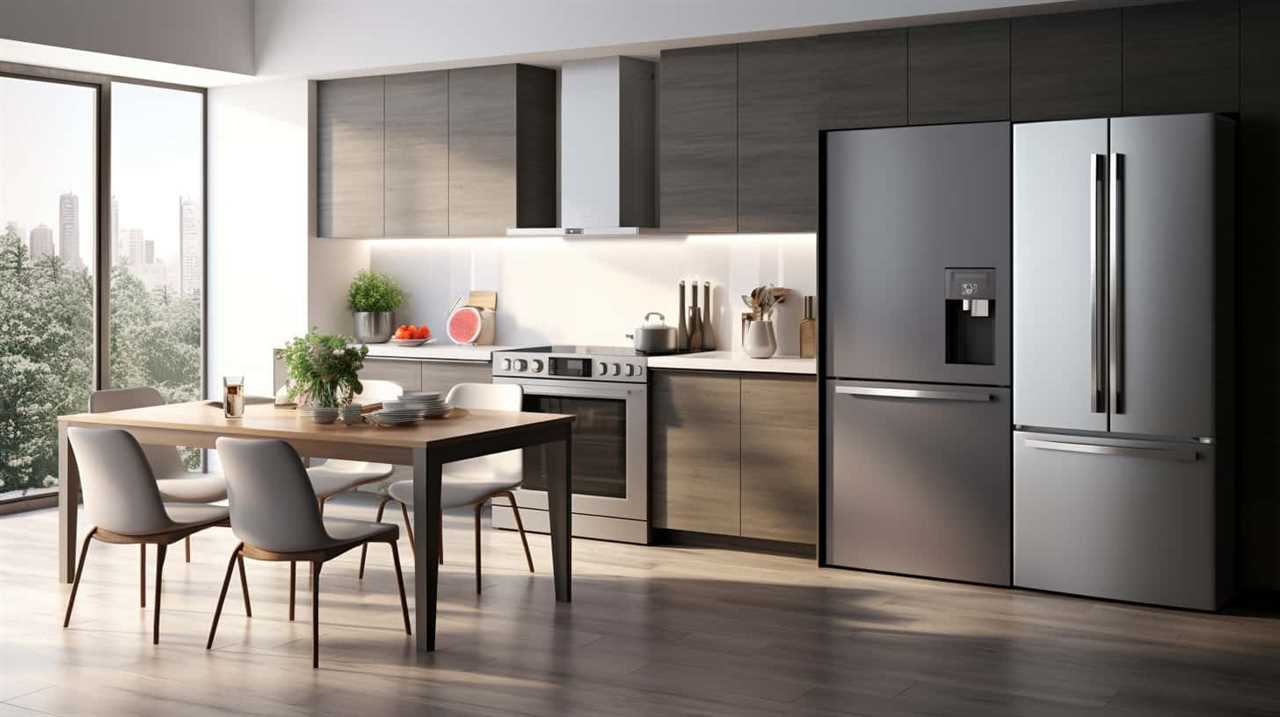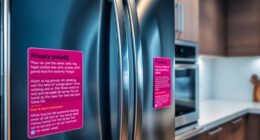Can we plug all of our appliances into a power strip to maximize convenience and efficiency?
The answer depends on several factors, including the power strip’s capacity, the ratings of the appliances, and potential hazards of overloading.
In this article, we will explore the safety considerations, best practices, and alternatives for plugging appliances into power strips.
By understanding these guidelines, you can ensure the optimal performance and safety of your devices.

Key Takeaways
- Check the wattage rating of the power strip before plugging in appliances
- Avoid using extension cords with power strips
- Regularly inspect the power strip for wear or damage
- Do not plug high-power appliances into power strips
Safety Considerations
When it comes to plugging appliances into a power strip, safety should be our foremost concern. To ensure appliance safety and prevent electrical fires, there are some important precautions to consider.
- Always check the wattage rating of the power strip and make sure it can handle the combined load of the appliances you plan to plug in. Overloading the power strip can lead to overheating and potential fire hazards.
- Avoid using extension cords with power strips as they can increase the risk of electrical fires.
- It’s also crucial to inspect the power strip regularly for any signs of wear or damage and replace it if necessary.
- Never plug high-power appliances, such as heaters or air conditioners, into power strips as they may exceed the strip’s capacity and pose a significant fire risk.
Types of Power Strips
There are various types of power strips available for safely plugging appliances into. Power strip features can vary depending on the brand and model. Some power strips have surge protection to safeguard your appliances from electrical surges. This feature is especially important for sensitive devices like computers and televisions.
Other power strips may have built-in USB ports, allowing you to charge your devices without the need for extra adapters or plugs. Additionally, some power strips offer individual outlets that can be controlled separately, providing greater flexibility and convenience.
It’s important to choose a power strip that suits your specific needs and meets safety standards. Now, let’s delve into the next section about power strip capacity and ratings to ensure you’re using your power strip correctly.

Power Strip Capacity and Ratings
Let’s explore the capacity and ratings of power strips to ensure we understand how to properly use them.
It’s important to be aware of the power strip limitations and capacity limits to avoid overloading and potential hazards. Power strips are designed to handle a specific amount of electrical current, which is indicated by their ratings. The rating is typically measured in amps and can vary from strip to strip.
Exceeding the power strip’s capacity can lead to overheating, fire, or damage to your appliances. To determine the capacity limits of a power strip, check the manufacturer’s specifications or look for the amp rating on the strip itself.
It’s crucial to never exceed the power strip’s capacity to ensure the safety and longevity of your appliances and the strip itself.

Understanding Appliance Power Requirements
When plugging appliances into a power strip, it’s crucial to understand their power requirements. We need to consider the compatibility between the power strip and the appliances, ensuring that the strip can handle the wattage needs of each device.
Failing to do so can lead to overloading the power strip, which can result in damage to both the strip and the appliances.
Power Strip Compatibility
We can determine power strip compatibility by understanding the power requirements of our appliances. Power strip compatibility refers to the ability of a power strip to handle the power demands of our appliances without overheating or causing electrical hazards.
To ensure power strip safety, it’s crucial to consider the wattage and amperage ratings of both the power strip and the appliances we plan to connect to it. The wattage rating indicates the maximum power that the power strip can handle, while the amperage rating indicates the maximum current the power strip can safely provide.

Appliance Wattage Limits
To understand appliance power requirements, it’s important to consider the wattage limits of our appliances. Here are three key factors to consider when it comes to appliance wattage limits:
- Appliance Power Consumption: Each appliance has a specific power consumption, measured in watts. This indicates the amount of electrical power it requires to operate efficiently. It’s crucial to know the power consumption of our appliances to ensure we don’t exceed the capacity of a power strip.
- Power Strip Capacity: Power strips come with different wattage capacities. It’s essential to check the maximum wattage that a power strip can handle. Exceeding this limit can lead to overheating, electrical hazards, or even damage to our appliances.
- Load Balancing: Distributing the total power consumption among multiple power strips can help prevent overloading. By evenly spreading the load, we can ensure that each power strip remains within its capacity limits, reducing the risk of electrical issues.
Understanding these appliance wattage limits will help us make informed decisions when plugging appliances into power strips, ensuring the safety and efficiency of our electrical setup.
Now let’s explore the potential risks of overloading power strips.
Overloading Power Strips
To avoid overloading power strips, it’s important to understand the power requirements of our appliances. Overloading a power strip can lead to power strip fire hazards and pose serious electrical safety risks.

Each power strip has a maximum load capacity, typically measured in amps, which shouldn’t be exceeded. It’s crucial to check the power rating of each appliance before plugging it into a power strip. This information can usually be found on the appliance’s label or in the user manual.
Additionally, it’s important to consider the total power consumption of all the appliances connected to a power strip. By calculating the total power requirements and ensuring they’re within the power strip’s capacity, we can prevent overloading and reduce the risk of power strip fire hazards and electrical accidents.
Potential Hazards of Overloading Power Strips
Using too many appliances on a power strip can lead to potential hazards. It’s essential to understand the potential dangers of overloading power strips to ensure safety in our homes or workplaces.
Here are three key hazards to be aware of:

- Electrical fires: Overloading a power strip can cause overheating, which increases the risk of an electrical fire. When too much current flows through the strip’s internal wiring, it can generate excessive heat that may ignite nearby flammable materials.
- Melting or damaged cables: When a power strip is overloaded, the excessive current passing through the cables can cause them to overheat. This can lead to melting or damage to the insulation, exposing live wires and creating a significant safety hazard.
- Circuit breaker tripping: Overloading a power strip can exceed its maximum capacity, causing the circuit breaker to trip. This interrupts the flow of electricity, preventing any further damage or potential hazards.
To avoid these potential dangers, it’s crucial to use power strips responsibly and not exceed their recommended limits.
The Importance of Proper Grounding
Now, let’s delve into the importance of proper grounding when plugging appliances into a power strip.
Proper installation and grounding are crucial for electrical safety. When an appliance is plugged into a power strip, it’s essential that the power strip is grounded. Grounding provides a safe path for electrical current to flow in the event of a fault or electrical surge. It helps to prevent electrical shock and reduce the risk of fire.
To ensure proper grounding, power strips should be installed according to manufacturer guidelines and in compliance with local electrical codes. This includes using a grounded outlet and making sure that the power strip’s grounding prong is securely connected to the outlet’s grounding terminal.

Proper grounding is a fundamental aspect of electrical safety and should never be overlooked.
Using Surge Protectors for Added Protection
We prefer using surge protectors for added protection when plugging appliances into a power strip. Surge protectors offer a range of benefits and features that help safeguard our electrical devices and prevent damage from power surges.
Here are three reasons why surge protectors are a wise investment:
- Voltage regulation: Surge protectors monitor and regulate the voltage supplied to our appliances, ensuring a stable and consistent flow of electricity. This prevents voltage spikes that can damage sensitive electronics.
- Surge suppression: Surge protectors are equipped with surge suppression technology that diverts excess voltage away from our devices. This helps to absorb and dissipate the energy from power surges, protecting our appliances from potential harm.
- Multiple outlets: Surge protectors come with multiple outlets, allowing us to connect multiple appliances simultaneously. This not only provides convenience but also ensures that all our devices are protected by the surge protector’s features.
Best Practices for Plugging Appliances Into Power Strips
When it comes to plugging appliances into power strips, it’s important to follow safety guidelines to prevent any potential hazards.

First, ensure that the power strip is compatible with the appliances you’re connecting. Some appliances, like refrigerators or air conditioners, require a higher wattage rating than standard power strips can handle.
Safety Guidelines for Power Strips
To ensure safety when plugging appliances into power strips, it’s important to follow these best practices:
- Safety Precautions:
- Before plugging an appliance into a power strip, check its wattage rating and ensure it doesn’t exceed the strip’s capacity. Overloading a power strip can cause overheating and fire hazards.
- Additionally, avoid using extension cords with power strips as they can increase the risk of electrical faults.
- Power Strip Maintenance:
- Regularly inspect your power strips for any signs of damage or wear. Look for frayed cords, loose connections, or exposed wires.
- If you notice any issues, replace the power strip immediately to prevent electrical accidents.
- Also, keep the power strips away from water sources and make sure they’re placed on a flat, stable surface.
- Proper Usage:
- Never daisy-chain power strips or connect multiple high-powered appliances to a single strip. This can lead to excessive power draw and increase the risk of electrical fires.
- Instead, distribute appliances across multiple outlets or use separate power strips for different devices.
Compatibility Between Appliances and Power Strips
Our main concern when plugging appliances into power strips is ensuring compatibility between the two. Power strip compatibility refers to whether the power strip can handle the electrical requirements of the appliances connected to it.
Each power strip has a maximum wattage limit, which is the total amount of power it can safely handle. Before plugging in appliances, it’s crucial to check their wattage ratings. This information is typically found on a label or in the user manual.

If the combined wattage of the appliances exceeds the power strip’s limit, it can overload the strip and pose a fire hazard. To ensure compatibility, it’s advisable to use power strips with a higher wattage rating than the appliances being plugged in. This will ensure a safe and efficient power supply for the appliances.
Alternatives to Power Strips for High-Power Appliances
We recommend considering alternative options for connecting high-power appliances instead of using power strips. While power strips are suitable for low-power devices, they may not be able to handle the high electrical load of appliances such as refrigerators, air conditioners, or space heaters.
Here are three alternatives to power strips for high-power appliances:
- Dedicated circuits: Install dedicated circuits for high-power appliances. These circuits have their own circuit breaker and wiring, ensuring that the appliance receives the necessary electrical supply without overloading the circuit.
- Extension cords: Use heavy-duty extension cords specifically designed for high-power appliances. Make sure the cord is rated for the appliance’s power requirements and length. Avoid daisy-chaining multiple extension cords together, as this can increase the risk of electrical hazards.
- Wall outlets: Connect high-power appliances directly to wall outlets. Ensure that the outlet is properly grounded and meets the electrical requirements of the appliance.
Recommendations for Organizing and Managing Cords
In the realm of cord management, an essential recommendation is to utilize cable organizers. Cord organization is crucial for maintaining a tidy and efficient workspace.

Cable management solutions such as cable clips, cable sleeves, and cable ties can help keep cords neatly organized and prevent them from tangling or becoming a safety hazard.
Cable organizers not only improve the overall appearance of your workspace but also make it easier to locate and access specific cords when needed.
When organizing cords, it’s important to label them properly to avoid confusion. Additionally, consider using color-coded cable organizers to distinguish between different types of cords or devices.
Frequently Asked Questions
What Are Some Common Safety Precautions to Consider When Using Power Strips?
When using power strips, it is important to consider common safety precautions. These include ensuring proper grounding for the power strip and following best practices to prevent electrical fires.

Can Power Strips Be Used for All Types of Appliances?
Power strip compatibility depends on the wattage and amperage ratings of the appliances. However, power strips have limitations. High-power devices like refrigerators or air conditioners may overload the strip, causing safety hazards.
How Do I Determine the Power Strip Capacity and Ratings Needed for My Appliances?
When determining power strip capacity, we calculate the ratings needed for appliances. Consider the wattage of each device and add them up. Ensure the power strip’s wattage rating is higher than the total to avoid overloading.
What Are the Potential Risks of Overloading a Power Strip?
Overloading a power strip can lead to fire hazards and electrical malfunctions. It is important to be aware of the potential risks and ensure that the power strip’s capacity can handle the appliances plugged into it.
Are There Any Alternatives to Using Power Strips for High-Power Appliances?
Yes, there are alternatives to power strips for high-power appliances. However, it is important to consider the benefits of using power strips, such as surge protection and the convenience of multiple outlets.

Conclusion
In conclusion, it’s generally safe to plug appliances into a power strip as long as you consider the power strip’s capacity and ratings, understand the power requirements of your appliances, and avoid overloading the power strip.
However, it’s important to note that power strips aren’t recommended for high-power appliances.
An interesting statistic to consider is that according to the U.S. Consumer Product Safety Commission, an estimated 3,300 residential fires are caused by overloaded power strips each year.










